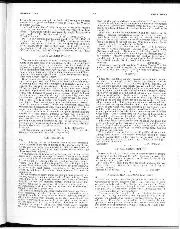
Justice?
Sir, I feel that the following may possibly be of interest to you, particularly in view of the fact that we are about to have an overall speed limit of…
THE AUSTIN “65” AN ATTRACTIVE AND ECONOMICAL SMALL
THE credit of displacing the small Continental sports car from the roads of England must be given to the Austin Seven, and though other cars of more modern design have ousted it from some of its former popularity, the Seven still has numerous adherents. The Ulster Austin, which had a special lowered chassis and a tuned engine, was naturally more suitable for speed events and the like, but was more expensive. The new ” 65 ” is fitted with the lowered chassis, and a sports engine, but is sold at a very reasonable figure, and should be welcomed by the numerous enthusiasts who are constantly asking how to convert their standard models. The car which we tested was fitted with a special Arrow body built for H. A. Saunders & Co., of The 13roadwalk, Golders Green, N.W.11. which strikes a new note in Austin coachwork.
. It goes without saying that a small engine must turn over rapidly to produce its power, but the Austin ran smoothly and without vibration throughout its range, although not mounted on rubber. It was quite flexible too, running on No. 1 petrol, but in order to get away quickly the gear-box had to be used freely. It was one of the best we have tried, with an easy and rapid change, and constant-mesh second and third gears. Third and top gears are fitted with synchro-mesh mechanism, an additional refinement rarely used. The clutch had a short travel, but took up the drive smoothly.
The steering was high-geared and light, but without much caster-action. This did not cause any difficulty as the wheel was easily centred, but a longer steering column would be appreciated by tall drivers, since at present the wheel rim is in contact with one’s driving rug.
The accelerator pedal is close beside the brake, so that in an emergency stop it is possibly to apply both at once. We therefore preferred to use the hand-lever, which also operates the four brakes, and using a fair amount of force we were able to pull up from 40 m.p.h. in 62 feet without any deviation from the straight. The position of the steering wheel and accelerator could be altered without much difficulty, if they were found to be inconvenient. In spite of these minor annoyances, the car was definitely pleasing to handle, for the driving position was good. The steering wheel and the gear-lever were right under one’s hand and the cut-away of the side of the body supported the right arm. With a short wheelbase car one can slip through traffic with the minimum of
delay, while the lowered chassis allows corners to be taken in exhilerating fashion. It also seems to have improved the comfort travelling over indifferent surfaces, and the tyres of 3. inch sectionare generous in proportion to the weight of the car.
The speeds in the gears are -30 m.p.h. on second, and 50 on third. The maximum on top was only 55 m.p.h., which was disappointing, even though the engine was still a little stiff, but it was found after the test that the ignition had been set it a position much too far retarted. The car is guaranteed by the makers to do 65 m.p.h. and there is no reason why it Should not do so. Even with retarded ignition the Austin maintained 45-50 m.p.h. under all main-road conditions.
The four-cylinder engine still retains its side valves, but has a downdranght induction system which improves accessibility. The two-bearing crankshaft is carried on roller bearings and is a specially stiff one with forced lubrication, and strengthened connecting rods are also fitted. A high-compression head and a high-lift camshaft are standard. The four-speed gear-box is in unit with the engine, and the propellor shaft is encased in a torque tube. The front axle is slightly V shaped in front view, and the transverse spring is set up with a reverse camber to lower the centre of gravity. The rear springs are quarter elliptics without camber for the same reason, and both sets are bound with tape.
The brakes are cable operated, and all • four are controlled by pedal and lever. They can be taken up simultaneously by means of a single wing-nut.
The body is one of the most successful we have seen on an Austin Seven. The wide louvred bonnet, reminiscent of the one used on the Ulster model, gives the car an appearance of solidarity, and the long swept wings avoid the impression of -stumpiness which one is liable to get on short wheelbase car. A seven gallon rear tank with a quick-action cap, is mounted at the rear of the body, and should take the car nearly 300 miles at a filling. The spare wheel is mounted vertically behind the tank.
The body is of ample width, and the two front seats, which have pneumatic upholstery, are adjustable. There is a space behind the seats large enough for several suitcases, or a third passenger could be carried in emergency. The hood is carried beneath the tonneau cover. -The battery is carried under the dash, and there is also a large felt-lined locker for tools.
As a fast and economical run-about the Austin is good value, and the pleasing lines of the Arrow body make it altogether a desirable little car.